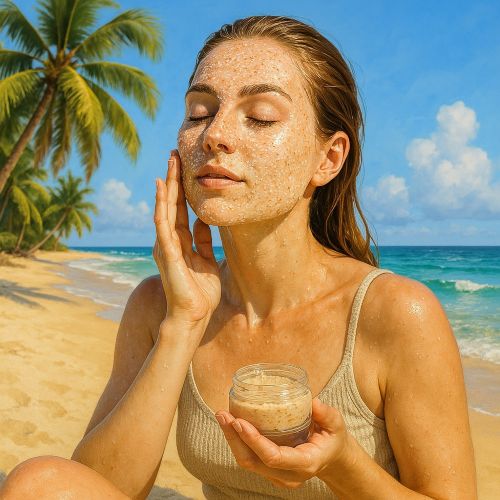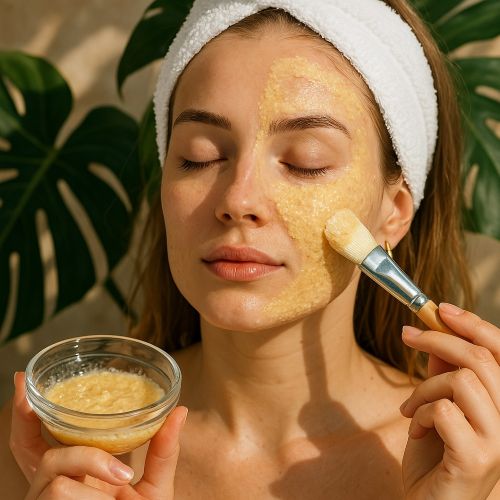-
 DIY: Video master classes
DIY: Video master classes
-
 Aromatherapy
Aromatherapy
-
 Felting master classes
Felting master classes
-
 Eating at home
Eating at home
-
 DIY cosmetics for children
DIY cosmetics for children
-
 Cooking recipes
Cooking recipes
-
 Detergents, cleaning products with your own hands
Detergents, cleaning products with your own hands
-
 Soap making as a business
Soap making as a business
-
 Natural cosmetics. Raw materials for cosmetics and soap.
Natural cosmetics. Raw materials for cosmetics and soap.
-
 Natural oils in cosmetics
Natural oils in cosmetics
-
 News
News
-
 Recipes for balms and conditioners
Recipes for balms and conditioners
-
 Bath Bomb Recipes
Bath Bomb Recipes
-
 Cream recipes. Cream making.
Cream recipes. Cream making.
-
 Lotion recipes. Gel recipes.
Lotion recipes. Gel recipes.
-
 Mask recipes
Mask recipes
-
 Soap recipes. Base soap. Soap from scratch.
Soap recipes. Base soap. Soap from scratch.
-
 Recipes for all occasions
Recipes for all occasions
-
 Natural shampoo recipes
Natural shampoo recipes
-
 Healthy Nutrition Recipes
Healthy Nutrition Recipes
-
 Scrub recipes. Massage tiles. Ubtan
Scrub recipes. Massage tiles. Ubtan
-
 DIY candles
DIY candles
-
 Reference materials, questions, tips
Reference materials, questions, tips
-
 Startup - soap production
Startup - soap production
-
 Hair care. Tips, recipes
Hair care. Tips, recipes
-
 Facial skin care. Cleansers.
Facial skin care. Cleansers.
-
 Body care. Tips, recipes
Body care. Tips, recipes
-
 Photo Reviews
Photo Reviews
-
 Chocolate Handmade
Chocolate Handmade
Is it possible to do peelings in the summer - rules, assets and a safe recipe
 The arrival of summer often brings a dilemma for skincare enthusiasts: can we continue our beloved exfoliation routines, particularly chemical peels, under the intense sun? The answer isn't a simple yes or no. While traditional, aggressive peels can increase sun sensitivity and the risk of hyperpigmentation during summer, gentle exfoliation with the right approach and ingredients is not only possible but can also be beneficial for maintaining healthy, radiant skin. This article delves into the rules, safe active ingredients, and provides a gentle DIY peeling recipe perfect for the summer months.
The arrival of summer often brings a dilemma for skincare enthusiasts: can we continue our beloved exfoliation routines, particularly chemical peels, under the intense sun? The answer isn't a simple yes or no. While traditional, aggressive peels can increase sun sensitivity and the risk of hyperpigmentation during summer, gentle exfoliation with the right approach and ingredients is not only possible but can also be beneficial for maintaining healthy, radiant skin. This article delves into the rules, safe active ingredients, and provides a gentle DIY peeling recipe perfect for the summer months.
Understanding the Concerns Around Summer Peeling
The primary concern with peeling in the summer is the increased risk of sun sensitivity. Exfoliating removes the outer layer of dead skin cells, which, while beneficial for revealing fresh skin, also makes the underlying layers more vulnerable to UV radiation. This heightened sensitivity can lead to sunburn, post-inflammatory hyperpigmentation (PIH), and other sun-related damage. Therefore, a cautious and informed approach is crucial.
Essential Rules for Safe Summer Peeling
- Prioritize Sun Protection: This is non-negotiable. Broad-spectrum sunscreen with a high SPF (30 or higher) must be applied diligently every morning and reapplied throughout the day, even on cloudy days.
- Choose Gentle Exfoliants: Opt for milder acids like lactic acid, mandelic acid, or fruit enzymes, which exfoliate more superficially and are less likely to cause significant irritation. Avoid strong AHAs (glycolic acid) and BHAs (salicylic acid) at higher concentrations.
- Lower the Frequency: Reduce the frequency of your peels compared to the cooler months. Once a week or even bi-weekly might be sufficient.
- Nighttime Application: Always perform your peeling routine in the evening to minimize sun exposure immediately after exfoliation.
- Listen to Your Skin: Pay close attention to how your skin reacts. If you experience any excessive redness, irritation, or peeling, reduce the frequency or discontinue use.
- Avoid Peeling Before Intense Sun Exposure: Do not perform a peel if you know you will be spending extended periods in direct sunlight in the following days.
- Hydrate and Moisturize: Support your skin barrier by using hydrating serums and a good moisturizer after peeling.
Safe Active Ingredients for Summer Peeling
1. Lactic Acid
A milder AHA derived from milk, lactic acid exfoliates gently while also having hydrating properties. Its larger molecular size compared to glycolic acid means it penetrates the skin more slowly, reducing the risk of irritation.
- Benefits: Gentle exfoliation, improves skin texture, hydrates, stimulates collagen production, less irritating than glycolic acid.
- Summer Suitability: Well-suited for summer due to its gentler nature and hydrating benefits.
2. Mandelic Acid
Derived from bitter almonds, mandelic acid is another gentle AHA with a larger molecular size. It's particularly beneficial for acne-prone and sensitive skin and has shown promise in treating hyperpigmentation.
- Benefits: Gentle exfoliation, improves skin tone and texture, helps with acne, addresses hyperpigmentation, less irritating.
- Summer Suitability: A good option for summer due to its mildness and potential to address summer-related skin concerns like mild breakouts.
3. Fruit Enzymes (e.g., Papain, Bromelain)
These natural enzymes derived from fruits like papaya and pineapple work by gently dissolving the protein bonds between dead skin cells. They offer a very mild form of exfoliation with minimal risk of irritation.
- Benefits: Very gentle exfoliation, brightens the skin, improves skin texture, suitable for sensitive skin.
- Summer Suitability: Excellent choice for summer due to their extremely gentle action.
DIY Gentle Summer Peeling Recipe: Papaya & Honey Mask
This homemade mask utilizes the natural enzymatic exfoliating properties of papaya combined with the hydrating and antibacterial benefits of honey. It's a mild and safe way to refresh your skin during the summer.
Ingredients:
- Ripe Papaya: 2 tablespoons, mashed
- Raw Honey: 1 tablespoon
- Optional: Lemon Juice: 1/2 teaspoon (use with caution and avoid if you have sensitive skin)
Preparation:
- In a clean bowl, mash the ripe papaya until it forms a smooth pulp.
- Add the raw honey to the mashed papaya and mix well until you have a consistent paste.
- If using, add the lemon juice and mix thoroughly. Lemon juice can increase sun sensitivity, so use sparingly and only if your skin tolerates it well. Skip this ingredient if you have sensitive skin or plan on sun exposure soon after.
Application:
- Cleanse your face with a gentle cleanser and pat it dry.
- Apply the papaya and honey mask evenly over your face, avoiding the eye area and lips.
- Leave the mask on for 10-15 minutes.
- Rinse thoroughly with lukewarm water and gently pat your skin dry.
- Follow with a hydrating serum and a broad-spectrum sunscreen with a high SPF.
Storage:
This DIY mask is best used immediately. Due to the fresh ingredients, it is not recommended to store leftovers.
Advantages of This DIY Gentle Peel Over Industrial Analogues
- Natural and Gentle: This recipe uses natural enzymes that provide a very mild form of exfoliation, minimizing the risk of irritation compared to stronger chemical peels found in some industrial products.
- Hydrating and Nourishing: Honey is a natural humectant, drawing moisture into the skin, and papaya contains vitamins and antioxidants that nourish the skin.
- Customizable: You control the ingredients and can omit lemon juice for a gentler version suitable for sensitive skin.
- Cost-Effective: The ingredients are readily available and often more affordable than specialized industrial peeling products.
- Fresh and Preservative-Free: You know exactly what you're putting on your skin, without worrying about harsh chemicals or artificial preservatives.

Important Considerations and Recommendations
- Sunscreen is Key: We cannot stress this enough. Consistent and diligent sunscreen application is paramount when performing any form of exfoliation, especially during summer.
- Patch Test: Always perform a patch test on a small area of your skin before applying any homemade mask or peel to your entire face to check for any adverse reactions.
- Listen to Your Skin: If you experience any discomfort or irritation, discontinue use immediately.
- Consult a Dermatologist: If you have any pre-existing skin conditions or concerns, it's always best to consult a dermatologist before incorporating any new exfoliating treatments into your routine.
Summer doesn't have to mean abandoning exfoliation. By understanding the risks, adhering to strict sun protection, choosing gentle actives, and opting for DIY recipes like the papaya and honey mask, you can safely maintain smooth, radiant skin throughout the sunny season. Remember, consistency and listening to your skin are the keys to successful summer skincare.
Mylo Opt Cosmetics Blog – Your Reliable Guide to Beauty and Care
Welcome to the Mylo Opt cosmetics blog! Here, you will find valuable advice, interesting recipes, and professional recommendations for creating soap, cosmetics, and candles with your own hands. Our blog is designed for anyone passionate about natural cosmetics, looking for new ideas, and wanting to learn more about producing high-quality skincare and haircare products. We share tested recipes, useful tips, and the latest news from the world of cosmetics.
Why Choose the Mylo Opt Cosmetics Blog?
Mylo Opt is not just an online store; it is a community of people passionate about creating natural cosmetics. Here are a few reasons why our blog will be useful to you:
- Experience and Expertise: Our authors are experienced cosmetologists, soap makers, and aromatherapy specialists. We share reliable and tested recipes that have undergone thorough testing and received positive feedback.
- Credibility and Authority: We ensure that all information in our blog is up-to-date and reliable. We reference scientific research and verified sources so that you can trust the quality of the information provided.
- Reader-Focused: Our content is tailored to you – our readers. We strive to answer your questions, solve your problems, and inspire new achievements in the world of natural cosmetics.
Popular Products from the Mylo Opt Online Store
Before we move on to recipes and tips, let us introduce you to the most popular products from our online store, which will help you create high-quality and natural cosmetics:
- Soap Bases: High-quality soap bases allow you to create beautiful and beneficial handmade soaps. We offer glycerin bases, bases with added oils and extracts, as well as transparent and white bases.
- Fragrance Oils and Fragrances: Give your products a unique scent with our fragrance oils and fragrances. We offer a wide range of scents – from fresh and floral to spicy and woody.
- Essential Oils: Essential oils are natural components that not only add fragrance to products but also offer beneficial properties for the skin and hair. Our range includes lavender, mint, eucalyptus, lemon, and many other oils.
- Active Ingredients: Vitamins, antioxidants, hyaluronic acid, and other active ingredients help improve the properties of your cosmetics. We offer only tested and high-quality components.
- Pigments and Dyes: Give your products bright and lasting colors with our pigments and dyes. They are safe for the skin and suitable for use in soap, cosmetics, and candles.
- Emulsifiers and Thickeners: To create creams and lotions, you will need emulsifiers and thickeners. We offer quality ingredients that help you achieve the desired consistency and stability of the product.
- Soap and Candle Molds: Create unique items with our soap and candle molds. Our range includes molds of various sizes and designs.
- Everything for Candles: Wax, wicks, fragrances, and dyes for candles – we have everything you need to create beautiful and fragrant candles.
Recipes and Tips for Making Handmade Soap
Cold Process Soap for Beginners
Making cold process soap is an exciting process that allows you to control all the ingredients and create unique recipes. Here is one simple cold process soap recipe for beginners:
Ingredients:
- 500 g olive oil
- 300 g coconut oil
- 200 g palm oil
- 150 g castor oil
- 120 g lye (sodium hydroxide)
- 300 ml distilled water
- Essential oils (lavender, mint, eucalyptus)
- Pigments or natural dyes (optional)
Process:
- Prepare all ingredients and tools. Always use protective gloves and goggles, as lye can be dangerous.
- Weigh the lye and water. Slowly add the lye to the water, stirring until it fully dissolves. Allow the mixture to cool to 40-45°C.
- Weigh the oils and melt them in a water bath. When the oils and lye solution reach the same temperature (about 40-45°C), slowly pour the lye into the oils, stirring constantly.
- Use an immersion blender to mix until trace (when the mixture thickens and leaves a trail when stirred).
- Add essential oils and pigments if desired. Mix thoroughly.
- Pour the mixture into a prepared mold and cover with a towel. Let the soap harden for 24-48 hours.
- Remove the soap from the mold and cut it into bars. Allow the soap to cure for 4-6 weeks before use.
Homemade Cosmetics Recipes
DIY Moisturizing Cream
Creating a moisturizing cream at home allows you to control the ingredients and adapt the recipe to your needs. Here is a simple recipe for a moisturizing cream:
Ingredients:
- 50 ml rose water
- 50 ml distilled water
- 10 g emulsifier (e.g., Olivem 1000)
- 10 ml jojoba oil
- 5 ml avocado oil
- 5 drops lavender essential oil
- 2 drops tea tree essential oil
Process:
- Weigh all the ingredients.
- In a water bath, melt the emulsifier with the oils until smooth.
- Separately, heat the water phase (rose water and distilled water) to the same temperature as the oil phase.
- Slowly pour the water phase into the oil phase, stirring constantly.
- Use an immersion blender to emulsify until you achieve a creamy consistency.
- Add essential oils and mix thoroughly.
- Pour the cream into a sterilized jar and allow it to cool.
DIY Candle Recipes
Aromatic Soy Candle
Creating aromatic candles is a creative process that allows you to experiment with scents and designs. Here is a simple recipe for a soy candle:
Ingredients:
- 200 g soy wax
- 20 ml fragrance oil (e.g., vanilla or lavender)
- Wick for candles
- Dyes (optional)
- Glass or metal candle mold
Process:
- Melt the soy wax in a water bath until liquid.
- Add the fragrance oil and dyes if desired. Mix thoroughly.
- Secure the wick in the center of the candle mold.
- Slowly pour the melted wax into the mold, holding the wick.
- Allow the candle to fully harden (about 24 hours).
- Trim the wick to the desired length and enjoy your aromatic candle.
Tips for Beginners in Cream Making
- Learn the Basics: Before starting to create creams, it is important to learn the basic principles and ingredients used in cream making.
- Experiment with Formulas: Do not be afraid to experiment with different ingredients and proportions to find the perfect formula for your skin.
- Use Quality Ingredients: The effectiveness and safety of your product depend on the quality of the ingredients. Always choose tested and natural components.
- Maintain Hygiene: It is important to maintain cleanliness and sterility when creating cosmetics to avoid contamination and spoilage of the product.
- Start with Simple Recipes: For beginners, it is best to start with simple recipes to master the basic techniques and principles of cream making.
Conclusion
Our Mylo Opt cosmetics blog is your reliable source of information and inspiration in the world of natural cosmetics. We share useful tips, tested recipes, and the latest news to help you create quality and effective products for skin, hair, and home care. Subscribe to our blog, follow the updates, and discover new opportunities in the world of natural cosmetics with Mylo Opt!





